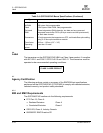
3 – QCP2340/2342
FCode
3-10 CF2351102-00 F
Q
3.4.5
Building the Bootable Disk
This procedure assumes that the system is already booted from an existing system
hard disk, and that you have already performed a full system backup.
The device path on each system differs, depending on the PCI bus slot, target ID,
LUN, etc. The device name shown in this example is for a device on the third PCI
bus slot, target ID 130, LUN 0, slice 0.
You must have already completed the steps in the previous sections before
attempting to create a bootable disk.
To build a bootable disk, perform the following steps:
1. Determine the amount of disk space used/available on your current boot disk.
Use the df command for a listing. For example:
/usr/bin/df -k -l
This df example shows that the current boot disk is /dev/dsk/c0t0d0s(x). There
are two partitions of interest, slice 0 (/) and slice 7 (/home). Slice 0 uses 1.65 GB
and has 875 MB free. Slice 7 uses 114 MB and has 5 GB free. Therefore, slice 7
(/home) contains enough disk space to store the temporary saveset files.
If there were not at least 1.7 GB free on this disk, you would need to create a
partition on the new bootable disk large enough to hold the largest temporary
saveset files plus the largest used space on a partition. In this example, it would
be a 3.2 GB (1.6 GB+1.6 GB) partition.
2. Use the format command to create, label, and format partitions on the new
bootable disk. These partitions must be able to contain the contents of your
temporary saveset files. If you are not familiar with the format command, refer
to the Solaris documentation.
WARNING!!
Misusing the format command can destroy the data on your
current disk drives.
Filesystem
/dev/dsk/c0t0d0s0
/proc
fd
mnttab
swap
swap
/dev/dsk/c0t0d0s7
kbytes
2577118
0
0
0
1310480
1311344
5135326
used
1650245
0
0
0
0
864
114
avail
875331
0
0
0
1310480
1310480
5083859
capacity
66%
0%
0%
0%
0%
1%
1%
Mounted on
/
/proc
/dev/fd
/etc/mnttab
/var/run
/tmp
/home


















